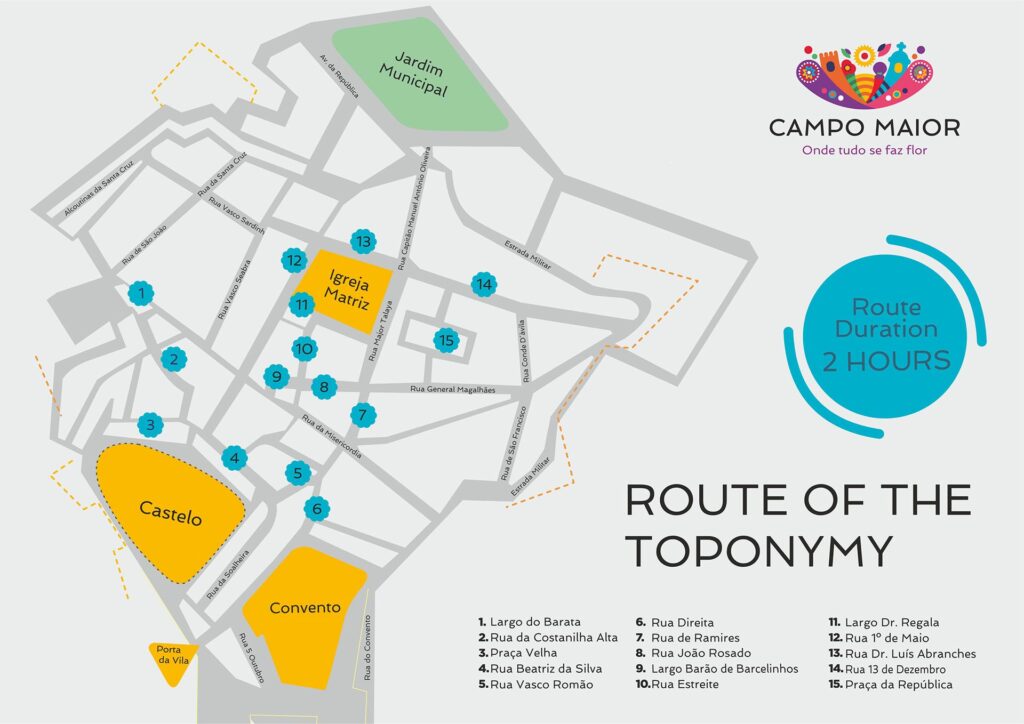1 – Largo do Barata
We start the tour in Largo do Barata, or rather, Largo d’Albuquerque Barata, which owns his name to the father of the illustrious Viscount d’Olivã. This square is also known as Terreiro da Estalagem, Largo do Assento (building that houses the Open Museum and the House of Flowers), Largo da Lagoa, or Alagoa.
2 – Rua da Costanilha Alta
After leaving Casa do Assento and turning right, we begin to climb a street whose name, of Spanish origin, derives from being a steep road: Street Costanilha Alta.
3 – Praça Velha
The Costanilha Alta street leads us to the Velha Square, the old main center of the village. Among the streets to which the Velha Square gives access, the General Rodrigues da Costa street stands out, which in 1908 presided over the commission of Army officers for the commemoration of the Centennial of the Peninsular War.
4 – Rua de Beatriz da Silva
Once we turned left and after leaving the Velha Square behind, we entered Santa Beatriz da Silva´s Street (also known as Barreira´s Street), one of the most illustrious figures in the history of Campo Maior. She was born in this village in 1424 and was the founder of the Contemplative Order of the Immaculate Conception (also known as Franciscan Conceptionists). You will pass through a small niche and a panel of tiles that mark the building where Santa Beatriz was born and lived.
5 – Rua Vasco Romão
Almost at the end of Santa Beatriz´s Street, on the left side, is Vasco Romão´s street, whose slope makes it also known as Quebra-Costas´s Street. The descent of this street, relatively narrow.
6 – Calle Direita (Rua Direita)
At the end of Vasco Romão street we enter Direita street and at the crossroads to the left we will continue along Ramirez street.
7 – Rua de Ramirez
Ramirez Street, one of the oldest in the village, could be associated with the congregation of Ramirez clerics, also present in Évora. As you enter this street, notice the first building on the right, which has a bas-relief on its parapet. According to popular tradition, the populations that lived scattered throughout the fields and therefore easily vulnerable to attacks decided to seek a larger space through the existing forest and reside there. The bas-relief that we find here represents three faces that, it is said, would be those of the first men to inhabit Campo Maior. After passing this beautiful example of architecture from the early 19th century, take the first left: João Rosado street.
8 – Rua João Rosado
João Rosado Street is also known as Cigano Street. According to an oral tradition, a cattle trader who became a rich farmer would have resided here.
9 – Largo do Barão de Barcelinhos
João Rosado Street leads us to Largo de Barão de Barcelinhos (also known as Largo do Terreiro, or simply Terreiro), later named Visconde de Ouguela. The viscount stood out for his philanthropic and idealistic character. In 1867 he assumed the leadership of the commission that defended together with the government and the King the defense for the continuation of the municipality, threatened with dissolution by administrative reform.
10 – Rua Estreita
If we go back a few meters and continue along João Rosado Street, we will find Estreita Street on the left. The street (really narrow) has a slight incline that ends at Largo de Dr. Regala. During the tour, we can already glimpse one of the bell towers of the Campo Maior Mother Church.
11 – Largo Dr. Regala
José Maria Regala, despite being a native of Ílhavo, was a municipal doctor in Campo Maior and here he had a great influence. This square is also known as Largo of Matriz or Largo of Igreja Nova. Taking the widest exit of the square and turning right, we will continue the tour along Primeiro de Maio street.
12 – Rua Primeiro de Maio
Previously called Visconde d’Olivá street, Primeiro de Maio street was named after April 25, 1974. In this street we can see interesting examples of civil architecture from the 19th century, of which its decorative motifs stand out, as well as some elements architectural at the height of the windows and doors. At the end of the block, this street is intercepted on the left by Lourenço Caiola Street and on the right by Dr. Luís Abranches Street. The first (formerly called Mouraria de Baixo) pays tribute to a former Campomaiorense, a senior army officer, journalist, writer, teacher and editor of the Diário de Notícias. Even within this street we can see a beautiful example of civil architecture with a coat of arms.
13 – Rua Dr. Luís Abranches
We continue along Dr. Luís Abranches street (old Mouraria de Cima) that pays tribute to an illustrious doctor who lives in this village, although he was a native of the municipality of Tábua.
14 – Rua 13 de Dezembro
If we follow Dr. Luís Abranches street until the end, we will cross Major Talaya street, a former major of the British army who defended the Campo Maior fortress during the French invasions and we will arrive at 13 de Diciembre street. This street recalls the date when the population of Campo Maior mutinied and began a general strike as a form of protest against the decision taken in 1867 to suppress Campo Maior as the seat of the municipality. In this street we can see various buildings of civil architecture with architectural elements at the height of the windows, balconies and portals that refer us to a modern and contemporary chronology.
15 – Praça da República
From 13 de Dezembro Street there is a small artery that leads us to the end of this route: República Square. Formerly known as Luís I Square or Nova Square (as opposed to Velha Square, next to the castle). This square houses the village´s Pillory and the Town Hall, installed in a beautiful 17th-century building.






